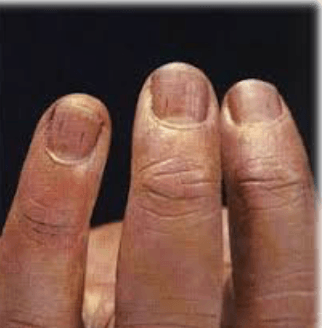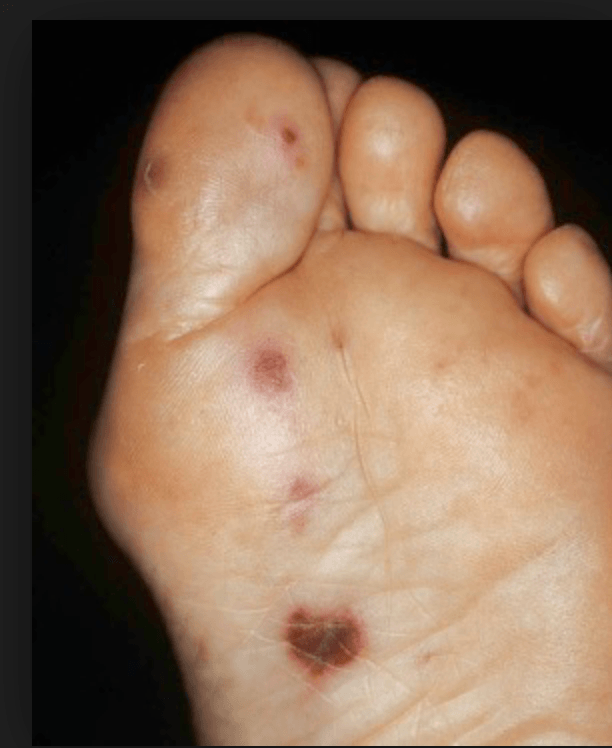Temperature >38C and WBC <4000 are two of four possible findings in this set of criteria
SIRS Criteria
Temp >38, <36; WBC >12K or <4k or >10% bands
Bonus - what are the other two criteria?
- OLD criteria for diagnosing sepsis
- felt to be nonspecific - can have changes in these parameters that are not related to sepsis and in fact are an appropriate/adaptive systemic response
- NOW the definition of sepsis relies on the organ dysfunction that results from the systemic response, essentially, getting out of control
First line/preferred fluids for resuscitation
Crystalloids (lactated ringers, normal saline)
- no studies that directly compare NS with balanced salt solutions in sepsis
Frequency of lactate draws when your patient is acutely septic
Use your judgement!!
Often start with at every 4-6 Hours
but if they are getting worse - may need (i.e.) Q2H, if getting better, may need less frequent
Goal: normalization (then stop checking!)
52yo with PMH notable for HTN, HLD, alcohol use and IVDU presents with fevers, sweats, cough, and malaise for the last 2 days.
Does not take any medications. Last hospitalization was for EtOH withdrawal last year. Lives at a homeless shelter or on the streets. Has had a few episodes in prison throughout his life. Unknown vaccination history.
102F. HR 120. BP 100/60. RR 18. 92% on room air.
Thin, tired appearing gentleman. Exam notable for appearing uncomfortable. Poor dentition. Palpable cervical LAD. Normal heart and lung sounds. No HSM.
1. What labs do you want?
Basic: CBC with diff, CMP, UA, CXR, Blood cultures
Could also get HIV, Hepatitis labs, procalcitonin, drug screen...
What additional intervention is needed when you find strep bovis bacteremia
Strep bovis -- patient needs a colonoscopy
What about Candidemia?
Shock differential - four big categories
Distributive (septic, neurogenic, anaphylactic, drug/toxin, endocrine)
Cardiogenic
Hypovolemic (hemorrhage)
Obstructive (PE)
empiric treatment for c diff
oral vancomycin
bonus: treatment of fulminant disease?
Ongoing hypotension despite adequate fluid resuscitation in the setting of suspected infection
What is septic shock?
This is the nonspecific, old definition
NOW, more specific: sepsis + vasopressors needed to maintain MAP >65, and having a lactate>2 despite adequate volume resuscitation (document!)
Bonus: Why MAP 65?
You have reached appropriate resuscitation after patient has received ____ amt of fluids
30ml/kg
Bonus - over what time frame?
These three things are considered the cornerstone therapies for treating sepsis
Early antibiotics
Volume Resuscitation
Vasopressors
On further exam -- any other studies to add?


Echocardiogram; evaluate for endocarditis
type of renal stone associated with recurrent urinary tract infections
struvite / staghorn
Hemodynamic (RA pressure, PCWP, Cardiac Index, SVR) findings in septic shock
RA - normal to low
PCWP - normal to low
Cardiac Index - typically high
SVR - low
Bonus: expected mixed venous?
Empiric CAP treatment on the wards? CAP treatment in the ICU?
ward: beta lactam + (azithro or doxy)
ICU: beta lactam + (azith or fluoroquinolone)
This is the new scoring criteria as defined by the most recent (2016) international conference on sepsis which defines sepsis by organ dysfunction
What is the SOFA score?
Bonus: Sepsis is defined by ____ point change in sofa score?
--> reflects mortality risk of 10% in general hospital population
True/False: albumin is an equally appropriate resuscitation fluid in the setting of septic shock
TRUE
- technically, colloids (albumin) could be used (no mortality differences noted in studies) - but more expensive
--> could be beneficial adjunct, however, in those patients with low oncotic pressure/hypoalbuminemia
70yo gentleman presents to the ED with nausea, vomiting, diarrhea for 3 days. PMH HTN, T2DM, COPD, atrial fibrillation. Meds include warfarin, amlodipine, metformin. Endorses dysuria, shortness of breath.
Temp 98.3F, HR 130, BP 90/40, RR 26, 96% on RA
Appears drowsy, but oriented. Exam largely normal with exception of tachycardia and diffuse abdominal tenderness.
Labs notable for WBC 21K, Na 132, HCO3 21, Creat 2.2 (Bl ~1.0) Lactic 4.2. UA with 36 RBC, >180 WBC, + LE. CT abd w/o contrast shows large obstructing calculus in the right ureter with hydronephrosis and possible forming abscess.
Fluids and antibiotics are started, blood cultures are pending. In this patient, what else do you need to consider?
surgery
This is an example of source control - another important pillar in managing sepsis.
The mnemonic "SLASH" can help you remember to rule out "stones, lines, abscess, surgical conditions, and hardware" when thinking about source control in a patient
WBC 17 (80% PMN), Hgb 13, Plt 400K
Na 135, Cl 100, BUN 15, K 3.7, HCO3 23, Creatinine 1.3
Alk Phos 120, AST 80, ALT 41, Albumin 2.7
CXR with cavitary lesions bilaterally. TTE with tricuspid vegetation. Blood cultures pending. Started on vancomycin.
Awaiting transfer to the floor, he becomes more sleepy. Recheck of vitals show ongoing temp of 102, BP now 72/40. The ER provider appropriately starts normal saline boluses, and you are told his pressure improves. He arrives to the floor with a pressure of 85/50 (MAP 62), and you note he's now requiring 3L of oxygen. Hard to figure out how much fluids he got, repeat lactate pending.
... What is your plan:
things to note:
- fluids helped his BP, but now he is likely developing pulmonary edema
- time to start thinking about pressors
- could (maybe) try albumin in the interim -- small volume, will stay in the vessels and he has low albumin (recall, albumin 2.7)
Pt presents to ED confused, complaining of shortness of breath, productive cough, and explosive diarrhea, found to have temp 102, HR 45, sodium of 132 What test do you want? What treatment?
Legionella urinary antigen
azithromycin or levofloxacin
68yo gentleman with h/o CHFpEF, HTN, gout presents from home with chief complaint of shortness of breath. Found to be febrile and hypoxic to the upper 80s. Labs and imaging suggestive of pneumonia. Otherwise stable. Started on ceftriaxone and doxy and admitted to the floor. Sputum culture obtained in ED>
Overnight developed increasing oxygen requirements along with decreasing pressures. In addition to clinically assessing patient at bedside, starting fluids and increasing supplemental oxygen - what else are you going to do?
broaden antibiotics
get blood cultures, lactate, ABG, consider repeat CXR
- start with appropriate abx based on clinical history (in this case CAP)
- broaden if needed
What if patient had a history of ESBL and was presenting in urosepsis - which antibiotic would start with then?
empiric antibiotics for bacterial meningitis in a patient with HIV
vancomycin + ampicillin + cefepime
These three criteria are used to quickly evaluate those with likely sepsis at the bedside
1. Altered Mental Status (GCS </= 13)
2. SBP </= 100
3. RR >/= 22
-having 2 of these in the setting of suspected infection has been associated with greater risk of death or prolonged ICU stay (qSOFA)
Lactated ringers has this potential benefit over normal saline, particularly when massive amounts of fluids are required
Lower chloride --> less AKI, less renal replacement therapy in some studies
Your patient is persistently hypotensive despite three pressors, massive amounts of fluids and appropriate antibiotic therapy. What medication might be worth trying at this point?
Stress dose steroids
(hydrocortisone 50mg IV Q6H = total 200mg/day)
- steroids in septic shock are controversial
- current recommendation is to only use them when you cannot maintain BP despite adequate resuscitation and vasopressor use
You appropriately transfer him to the ICU and place a central line. He's sleepy. Vitals 100F, HR 110, BP 78/45, RR 22, on 3L o2, saturating 92%.
What is his Q Sofa Score?
3
altered, increased respiratory rate, SBP <100
Previously healthy patient presents to ED with abdominal pain, diarrhea (intermittently bloody) x10 days.
Labs notable for Hgb 8, Plt 55, Creatinine 2.4. LDH and bili are elevated. Smear shows evidence of hemolysis.
What bug caused this?
This is HUS. Caused by E.coli 0157:H7
39yo woman presents with extreme fatigue. Notes sore throat, runny nose, cough x3 days.
H/o hypothyroid for which she takes levothyroxine. No tobacco/drugs/etoh.
99F. 87/60. HR 110. 97% on room air. Exam unremarkable.
WBC 9, Na 131, K 4.9, Cl108, Bicarb 20, Creatinine 1.4, Glucose 64. UA 3-5 WBC, 1-2RBC.
Most likely etiology for patient's hypotension?
adrenal insufficiency
often present with NAGMA, hyponatremia, hypoglycemia. AKI due to hypovolemia.
What is the OUTpatient regimen for febrile neutropenia?
ciprofloxacin, augmentin
- allows to be outpatient if neutropenia isn't expected to last more than 7 days, if they are clinically stable and without significant complications
Components of SOFA score (5)
Respiration (PaO2/FiO2)
Coagulation (platelets)
Liver (bilirubin)
Cardiovascular (BP)
Brain (GCS)
Kidney (Creatinine, UOP)
https://www.mdcalc.com/sequential-organ-failure-assessment-sofa-score
You have adequately resuscitated your patient with IV fluids and are pleased that his mental status is improving, HR is coming down, lactate and creatinine all improving. However, he remains hypotensive. You are reluctant to start pressors in this setting - then you remember a tool that could help you predict whether or not he might respond to more fluids. What is it?
Most likely -- IVC assessment
but ANY dynamic evaluation (i.e. passive leg raise)
Bonus: What are you looking for on the IVC evaluation? What finding might prompt you to give more fluids (What might prompt you to start pressors)?
This pressor is a useful adjunct to norepinephrine when you need a second
Vasopressin
- acts on V1, V2 receptors (different mechanism than norepi)
Bonus: what might you add instead if your patient is having tachyarrhythmias?
The patient largely stabilizes and remains in the ICU. Cultures grow out staph aureus.
On hospital day five, you get a call from the nurse the this HR is now in the 50s, all other vitals are acceptable. You get an EKG that shows a new 1st degree heart block. You note that he continues to be febrile, blood cultures are persistently positive.
Plan?
needs source control = surgery
has persistent bacteremia and now heart block, indicating possible abscess formation
These four blood stream infections always require removal of central venous catheter removal
- staph aureus
- pseudomonas
- fungi (i.e. candida)
- mycobacteria
Patient is admitted with acute heart failure exacerbation due to medication noncompliance. He requires inotropes (dobutamine) due to evidence of cardiogenic shock. He subsequently improves (creatinine downtrends, weight comes down, decreased oxygen needs). On hospital hospital day 6, you notice his mixed venous jumps from 50 to 80%. What are you worried about?
Infection
Recall normal mixed venous (normal, functioning human) 60-80.
Will be LOW in cardiogenic shock, and often a bit on the low end at baseline for those with CHF.
if it JUMPS suddenly, and patient has an indwelling CVC -- be concerned for brewing infection (blood cultures, urine cultures, etc)
Mixed venous in SEPTIC shock will be ELEVATED
61 yo with h/o of CAD, HTN, COPD is evaluated in the ICU. Recent CABG six days ago. Still ventilated. He developed fever, increased oxygen requirements and abundant secretions are being suctioned from his ET tube every hour. He was started on zosyn.
Temp 102, BP 124/84, HR 96, RR 18, O2 90% on 60% FIO2, 5 of PEEP.
WBC 19 with neutrophil predominance. CXR with infiltrate. Blood cultures negative.
There is a vancomycin shortage. What therapy are you going to recommend?
linezolid
Patient has ventilator associated pneumonia (defn onset of pneumonia 48-72h after intubation)
need to cover for hospital acquired organisms -- including MRSA, MSSA, pseudomonas, stenotrophomonas, etc.
Vanco often go to - but many hospitals have a portion of MRSA isolates that vanco isn't great for (MIC >2) -- so linezold!